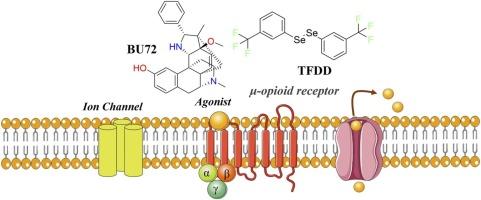m -三氟甲基二苯二烯与μ-阿片受体结合的分子动力学研究:吗啡诱导耐受的计算视角
IF 3.1
4区 生物学
Q2 BIOLOGY
引用次数: 0
摘要
慢性疼痛是一种不适应状态,疼痛信号持续超过预期的损伤或疾病的解决。吗啡和相关化合物,作为微阿片受体激动剂,是治疗这种情况的有效镇痛药。然而,长期给药吗啡可破坏μ OR贩运并激活β-抑制素介导的通路,导致阿片类药物耐受。µOR在情绪障碍中的作用尚不明确。有机硒化合物m-三氟甲基二苯二烯醚(TFDD)在实验模型中显示出良好的抗痛感和抗抑郁样作用,并减轻了小鼠的吗啡戒断症状然而,在原子水平上控制TFDD与µOR相互作用的分子机制仍未通过理论方法探索。为了弥补这一知识差距,目前的研究试图利用包括量子化学计算、分子动力学模拟和热力学分析在内的综合计算方法来表征TFDD的药理学特征。模拟结果显示,TFDD的三氯苯部分与µOR结合口袋内的特定残基Gln1242.60和Glu2995.58之间形成了持久的卤素键,键距分别为2.83和3.73 Å。这些相互作用跨越跨膜螺旋2- 5 (TM2-TM5),有助于在受体结合位点内稳定TFDD。值得注意的是,关键的微开关残基,如Asp1473.32、Met1513.36和Trp2936.48,对维持微或活性构象和调节β-阻滞蛋白信号至关重要,被观察到与TFDD相互作用。这些构象动力学随后影响G蛋白偏向的µOR激活。为了检查与TFDD和morphinan激动剂BU72结合的µOR的构象空间,采用主成分分析来确定主要的运动模式。随后,构建了自由能图,以确定能量有利的构象状态及其之间的转变,从而深入了解μ or配体结合配合物的热力学行为。此外,通过动态互相关矩阵分析来评估BU72和TFDD结合后µOR残基相关运动的差异。利用不同λ态的热力学积分计算炼金术自由能,定量估计了TFDD和BU72两种配体的结合亲和力。计算得到的总结合自由能值为:TFDD为−42.54 ± 1.92 kJ/mol, BU72为−39.76 ± 0.74 kJ/mol。本计算研究结合实验数据和原子水平建模,阐明了TFDD与µOR相互作用的分子基础。这增强了我们对TFDD降低吗啡耐受性、改善疼痛缓解和最小化副作用的潜力的理解,最终为开发更好的基于阿片类药物的疼痛管理策略提供了信息。本文章由计算机程序翻译,如有差异,请以英文原文为准。

Molecular dynamics study of M-Trifluoromethyl diphenyl diselenide binding to the μ-opioid receptor: A computational perspective on morphine-induced tolerance
Chronic pain is a maladaptive state where pain signals persist beyond the expected resolution of injury or illness. Morphine and related compounds, acting as µ-opioid receptor (µOR) agonists, are effective analgesics for managing this condition. However, chronic morphine administration can disrupt µOR trafficking and activate β-arrestin-mediated pathways, leading to opioid tolerance. The role of µOR in mood disorders is less well-defined. The organoselenium compound m-trifluoromethyl diphenyl diselenide (TFDD) has shown promising antinociceptive and antidepressant-like effects in experimental models and attenuated morphine withdrawal symptoms in mice.1 However, the molecular mechanisms governing TFDD's interaction with the µOR at the atomic level remain unexplored through theoretical methodologies. To bridge this knowledge gap, the current research sought to characterize the pharmacological profile of TFDD using an integrated computational approach that included quantum chemical calculations, molecular dynamics simulations, and thermodynamic analysis. The simulations revealed the formation of persistent halogen bonds between TFDD's trichlorobenzene moiety and specific residues within the µOR binding pocket, namely Gln1242.60 and Glu2995.58 with bond distances of 2.83 and 3.73 Å respectively. These interactions, spanning transmembrane helices 2 through 5 (TM2-TM5), contribute to the stabilization of TFDD within the receptor's binding site. Notably, key microswitch residues, such as Asp1473.32, Met1513.36, and Trp2936.48, which are critical for maintaining the µOR active conformation and modulating β-arrestin signaling, were observed to interact with TFDD. These conformational dynamics subsequently influence the G protein-biased activation of the µOR. To examine the conformational space of the µOR bound to TFDD and the morphinan agonist BU72, principal component analysis was used to determine the leading modes of motion. Subsequently, free energy landscapes were constructed to identify energetically favorable conformational states and the transitions between them, providing insights into the thermodynamic behavior of the µOR-ligand bound complexes. Furthermore, dynamic cross-correlation matrix analysis was performed to evaluate differences in the correlated motions of µOR residues upon binding of BU72 and TFDD. Alchemical free energy calculations, utilizing thermodynamic integration across various λ states, were employed to quantitatively estimate the binding affinities of both ligands TFDD and BU72. The calculated total binding free energy values were −42.54 ± 1.92 kJ/mol for TFDD and −39.76 ± 0.74 kJ/mol for BU72. This computational study elucidates the molecular basis of TFDD's interaction with µOR, integrating experimental data with atomic-level modeling. This enhances our understanding of TFDD's potential to reduce morphine tolerance, improve pain relief, and minimize side effects, ultimately informing the development of better opioid-based pain management strategies.
求助全文
通过发布文献求助,成功后即可免费获取论文全文。
去求助
来源期刊

Computational Biology and Chemistry
生物-计算机:跨学科应用
CiteScore
6.10
自引率
3.20%
发文量
142
审稿时长
24 days
期刊介绍:
Computational Biology and Chemistry publishes original research papers and review articles in all areas of computational life sciences. High quality research contributions with a major computational component in the areas of nucleic acid and protein sequence research, molecular evolution, molecular genetics (functional genomics and proteomics), theory and practice of either biology-specific or chemical-biology-specific modeling, and structural biology of nucleic acids and proteins are particularly welcome. Exceptionally high quality research work in bioinformatics, systems biology, ecology, computational pharmacology, metabolism, biomedical engineering, epidemiology, and statistical genetics will also be considered.
Given their inherent uncertainty, protein modeling and molecular docking studies should be thoroughly validated. In the absence of experimental results for validation, the use of molecular dynamics simulations along with detailed free energy calculations, for example, should be used as complementary techniques to support the major conclusions. Submissions of premature modeling exercises without additional biological insights will not be considered.
Review articles will generally be commissioned by the editors and should not be submitted to the journal without explicit invitation. However prospective authors are welcome to send a brief (one to three pages) synopsis, which will be evaluated by the editors.
 求助内容:
求助内容: 应助结果提醒方式:
应助结果提醒方式:


